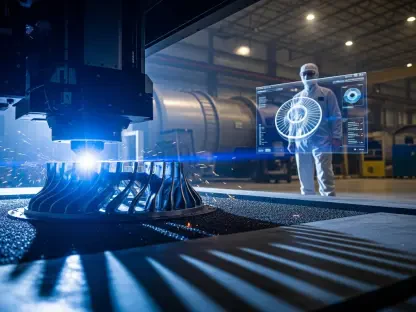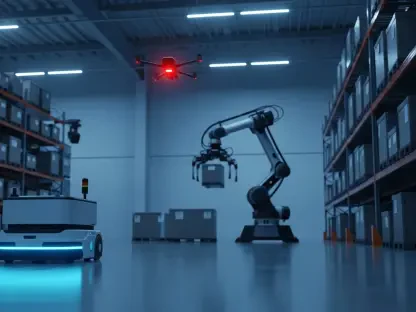In a world increasingly defined by geopolitical tensions and economic instability, manufacturers are grappling with the fragility of global supply chains, disrupted by everything from U.S. tariffs to conflicts such as the Ukraine-Russia war, which have exposed the risks of relying on distant suppliers. These events have pushed companies to seek alternatives closer to home. A striking 68% of top management executives now consider localized supply chains a top priority, signaling a seismic shift in strategic thinking. This isn’t merely a passing trend but a fundamental response to persistent global challenges, offering a pathway to greater stability. With 82% of companies noting enhanced resilience and 77% seeing cost savings from reduced transport expenses and currency volatility, the appeal of localization is undeniable. Yet, hurdles like elevated distribution costs and outdated infrastructure pose significant challenges. Thankfully, innovative strategies and technologies, especially Industrial AI, provide actionable ways to navigate these obstacles, ensuring manufacturers can adapt and thrive amid uncertainty.
Rethinking Operations for Localization
Product Design: Building Flexibility into the Core
The journey toward robust local supply chains begins with a fundamental overhaul of product design, addressing vulnerabilities tied to overly specialized components. Many manufacturers find themselves tethered to single-source suppliers or extended lead times due to custom parts, a risky position during geopolitical or economic disruptions. By embracing standardized, modular designs, companies can diversify their supplier base locally, significantly cutting down on delays and improving inventory management. This approach fosters agility, allowing swift adaptation to sudden market shifts or material shortages. The automotive sector’s pivot during the semiconductor crunch—opting for multipurpose chips over bespoke ones—serves as a powerful example. Despite a notable drop in global car sales, this flexibility helped curb further losses, underscoring how design innovation can fortify supply chains against unexpected shocks and maintain operational continuity.
Beyond the immediate benefits of reduced lead times, rethinking product design also enhances collaboration with local suppliers, creating a more interconnected and responsive network. Standardized components mean manufacturers aren’t locked into rigid supply agreements, giving them the freedom to source materials from multiple nearby vendors. This not only mitigates the impact of a single supplier’s failure but also drives down costs through competitive local sourcing. Additionally, modular designs simplify repairs and upgrades, extending product lifecycles and aligning with consumer demand for durability. Such strategic shifts in design philosophy lay a strong foundation for shorter, more resilient supply chains, capable of withstanding geopolitical pressures. As manufacturers refine their approach to product creation, they build a buffer against global volatility, ensuring they can pivot quickly without sacrificing quality or market position in an unpredictable landscape.
Remanufacturing: Sustainability Meets Cost Savings
Remanufacturing stands out as a compelling strategy for manufacturers aiming to bolster local supply chains while addressing environmental concerns. By establishing local centers for dismantling and repairing products, companies can upcycle materials, drastically reducing the need for raw material extraction and long-distance shipping. Recognized by the Environmental Protection Agency as a resource-conserving method, remanufacturing cuts carbon emissions tied to transport and production. The U.S. automotive remanufacturing market, for instance, is on track to reach $24.30 billion by 2030, fueled by the dual promise of cost efficiency and ecological benefits. This process not only lessens dependence on volatile global markets but also positions companies as stewards of sustainability, appealing to an increasingly eco-conscious consumer base and aligning with regulatory expectations for greener practices.
The integration of Industrial AI elevates remanufacturing to new heights, optimizing every stage of the process for maximum efficiency. Advanced algorithms assess which components can be reused, predict potential failures before they occur, and match parts to production demands with precision. This technology also identifies the shortest, most cost-effective supply routes, slashing freight expenses by 3-5% and trimming core safety stock by 2-4%. Such savings are critical when navigating the higher distribution costs often associated with localized operations. By leveraging AI, manufacturers ensure that remanufactured goods meet quality standards while minimizing waste and expedited shipping needs. This synergy of remanufacturing and cutting-edge tech creates a robust framework for local supply chains, balancing economic imperatives with environmental responsibility and reinforcing resilience against external disruptions.
Leveraging Technology for Resilience
Industrial AI: Staying Ahead of Disruptions
Industrial AI is rapidly emerging as a cornerstone for manufacturers striving to fortify localized supply chains against geopolitical upheavals. With only 5% of organizations currently able to foresee and address disruptions preemptively, and 75% stuck with static systems lacking cross-team collaboration, the need for dynamic solutions is glaring. AI bridges this gap by delivering real-time insights and sophisticated scenario planning, enabling companies to simulate potential crises and devise responses in mere minutes rather than days. Tools like agentic AI systems analyze vast datasets—covering supplier performance, weather patterns, and geopolitical risks—to recommend immediate actions. This shift from reactive to proactive management ensures production continuity, even amidst supplier delays or seasonal fluctuations, offering a critical edge in an unstable global environment.
Further enhancing its value, Industrial AI introduces groundbreaking approaches such as upside-down Material Requirements Planning, which recalibrates production based on existing inventory rather than outdated forecasts. This method prevents overstocking or shortages, optimizing resource use within a localized framework. Unlike traditional planning, which often takes a week to test limited scenarios manually, AI-driven systems adapt instantly to changing conditions, minimizing downtime and financial losses. The ability to anticipate and mitigate risks before they escalate transforms supply chain management into a strategic asset rather than a liability. As geopolitical tensions continue to challenge global trade, embracing AI equips manufacturers with the foresight and flexibility needed to maintain seamless operations, ensuring they remain competitive no matter the external pressures at play.
Sustainability Reporting: Transparency as a Competitive Edge
Sustainability has evolved from a peripheral concern into a central pillar of business strategy, particularly for manufacturers transitioning to localized supply chains. With 80% of American consumers willing to pay a premium for sustainable products, the demand for environmental accountability is reshaping market dynamics. Localization inherently supports this by shortening transport routes, thereby reducing emissions, and allowing closer scrutiny of supplier practices, from energy consumption to labor standards. Meeting stringent regulatory benchmarks, such as Scope 3 emissions targets, becomes more feasible when supply chains are geographically concentrated. This alignment not only ensures compliance but also builds credibility with investors and regulators who increasingly prioritize green initiatives as markers of corporate responsibility.
Industrial AI amplifies the impact of localized sustainability efforts by automating complex emissions tracking and producing transparent, auditable records. Such technology embeds eco-friendly practices into daily operations, making compliance a seamless part of the workflow rather than an added burden. Transparent reporting fosters trust among stakeholders, turning sustainability into a competitive differentiator in a market where ethical considerations sway purchasing decisions. Beyond mere numbers, this visibility into environmental impact helps manufacturers identify inefficiencies and implement corrective measures swiftly. As geopolitical storms drive the need for localized operations, integrating AI-driven sustainability reporting ensures that companies not only weather disruptions but also emerge as leaders in a landscape where environmental stewardship is synonymous with long-term success.
Charting the Path Forward with Strategic Innovation
Reflecting on the strategies that shaped responses to geopolitical challenges, it’s evident that manufacturers who adapted through localized supply chains gained a significant edge. The focus on redesigning products for flexibility, embracing remanufacturing for efficiency, leveraging Industrial AI for predictive insights, and prioritizing sustainability reporting proved transformative. These efforts turned vulnerabilities into strengths, allowing companies to navigate disruptions with confidence. Looking ahead, the path forward lies in deepening investments in technology and localized networks. Manufacturers should continue refining AI tools to enhance forecasting precision and expand remanufacturing capabilities to meet growing market demands. Strengthening partnerships with local suppliers will further solidify resilience, while transparent sustainability practices can secure consumer loyalty and regulatory favor. By building on these foundations, the industry can anticipate future storms, ensuring supply chains remain robust and adaptable in an ever-changing global arena.









